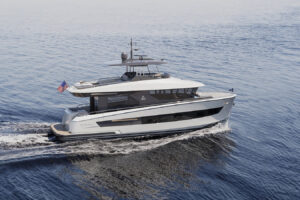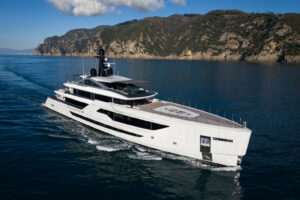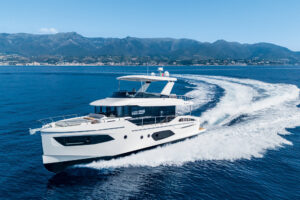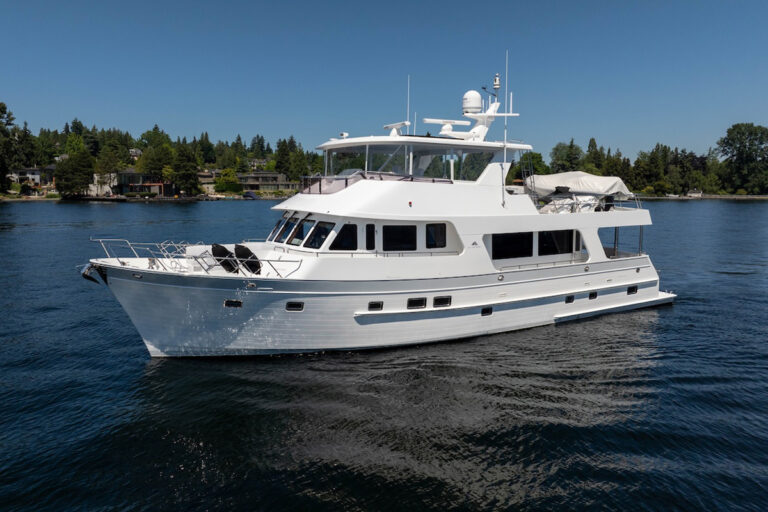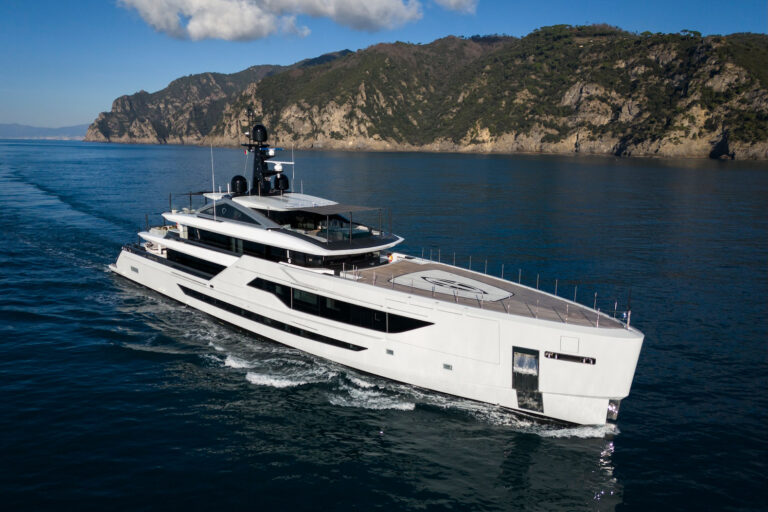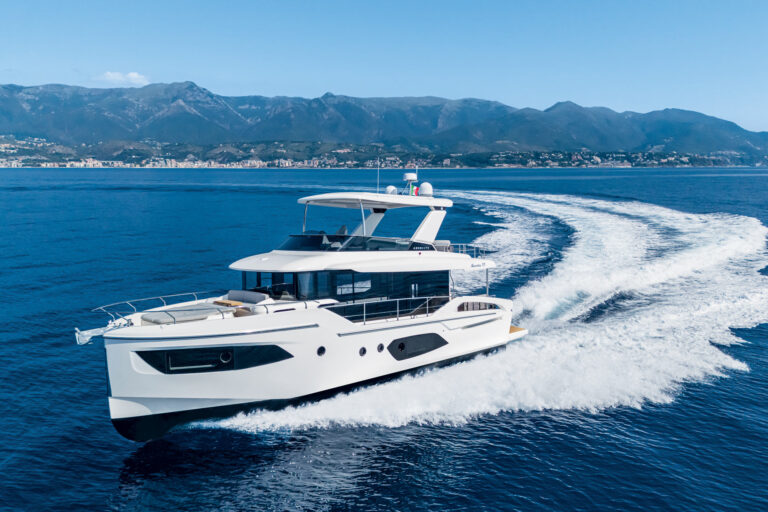The Bruckmann 47 Alizé III, like the girl next door, is uncannily seductive, as only a treasured friend can be. She disarms your protestations of love with her straightforward approach to life and deep understanding of what pleases you. She challenges your mask of independence by always being at your side when you need comforting. As if that weren’t enough, she looks fabulous dripping wet head to toe from a rainstorm.
Mark Ellis and Bruckmann Custom Yachts in Oakville, Ontario, molded Alizé III. Ellis created a timeless design, but he didn’t do so alone. Top-notch designs, this one among them, evolve from the sensibilities and experience of clients as much as they do from the designer. Ellis and his clients avoided all the clichés-carved trailboards, teak curlicues at the terminus of the safety rails, that sort of thing-that appear on lesser boats to draw attention from the mediocre. Everything on Alizé III has a good reason for being.
The design brief offered the following guidance: Create a solidly built, reliable and seaworthy cruising boat with the sweeping lines that attract so many to the Herreshoffs, Aldens, Rhodeses and Fifes. The clients wanted an uncluttered vintage look that maintained a sense of space and elegance, but they refused to tolerate any fussy or contrived elements. As you would expect of a modern sailing couple, they wished for all the amenities that make cruising comfortable, but they didn’t want to crowd the boat. Nor did they want to hurt her performance. They wanted everything in moderation and good taste.
That’s exactly what they got.
I caught up with Alizé III last winter at her home in Palm Beach, Florida, resting quietly in a slip outside her owners’ condominium. Boats were lined up like salmon at a Seattle fish market, but even here, Alizé III stood out. I needed some distance to appreciate fully the lovely sweep of her sheerline, but it exerted a powerful enough presence to let me know it’s out of the ordinary.
A few steps down the companionway stairs and bingo: This is what the phrase “feels right” means. The living spaces charmed me with a mix of white panels and overhead trimmed with varnished mahogany in the style of L. Francis Herreshoff. Her cozy C-shape galley encourages the creation of fine seagoing cuisine with an efficient layout, abundant dry and refrigerated stowage, and Corian counters. Substantial fiddles keep everything on the counters.
More magical touches appear at the engine box, which also houses the galley sink. Cruising couples are skipper, navigator, chef, steward and engineer, so anything that complicates their lives should be exorcised from the design. Alizé III’s engine box opens like an easily recalled puzzle box, allowing easy reach of all the engine’s vital organs. When surgery is necessary, the entire box lifts off. In theory, the owners could do a top-end overhaul without removing the engine.
Among the other thoughtful touches are a dedicated wet locker in the after head; a lee cloth on the settee berth portside, where the off-watch crew would sleep; secure bottle stowage in a cabinet against the forward bulkhead port side and a hanging locker over it; stowage cabinets in the saloon above the settees; and a large hanging locker in the master stateroom forward.
Sturdy latches on all the doors and drawers, plus dogged hatches in the cabin soles suggest everything stowed behind or beneath will stay if the boat takes a 360-degree roll or a knockdown.
As delightful as the accommodations are, they’re meaningless if the boat doesn’t sail well. We cast off about 90 minutes before high tide, with a window of about three hours to get out the Lake Worth Inlet to open sea and back in time to clear the fixed high-rise (65 feet) Riviera Beach bridge. During the course of the day, we got to know Alizé III fairly well.
Sailboats always seem out of sorts when they’re motoring, as if to say, “Sure, we can do this, but we’d rather be sailing.” Alizé III motors as well as any boat in her class, and the Yanmar is a reasonably quiet member of the crew. We can thank the engineers at Yanmar for the creation’s basic quiet nature, but most of the kudos go to the builder for selecting the best sound-insulating package.
After we cleared the last of the marker buoys in the Lake Worth Inlet channel, we set sail-full main and genoa-and bore off on a reach in winds of 12 to 15 knots, occasionally gusting to 20. Three sets of swept spreaders and running backstays mind the tapered aluminum mast, and an inner stay permits the use of the large staysail when weather conditions dictate. We belayed the runners forward near the mast, reasoning that we wouldn’t need them in these conditions. Electric/hydraulic winches let us trim the sails without breaking a sweat.
The GPS showed a speed of 8 knots. Heading up to about 32 degrees to the apparent wind slowed us to 6.5 knots. We weren’t focused, though. Maybe the time of day, the jokes and the chatter about the boating industry occupied our attention more than they should have. We had set the traveler too high, the genoa cars too far forward and the vang too loose for the conditions. Our sloppy sail trim let the gusts overpower her, but she shrugged off our carelessness and still treated us to a fun time. Her forgiving nature attests to the rightness of the design brief and Ellis’s interpretation of it.
Steering Alizé III requires just enough effort to let you know you’re controlling a rudder, and she responds to steering inputs like an obedient dog to a leash. This balanced elliptical rudder has a shoal-draft span but quite a lot of chord length. The keel, too, is shallow and of considerable chord length. Directional stability, assuming careful sail trim, ought to be first-rate.
The owners of Alizé III are a lucky couple, but they already know it. Even if they never turn the bow toward distant seas, they’ll be able to count their yacht as a dear friend for life.
Contact: Bruckmann Custom Yachts, (905) 825-5304, (888) 993-9958; fax (905) 825-0051; hey@harrisellis.com; www.harrisellis.com.

